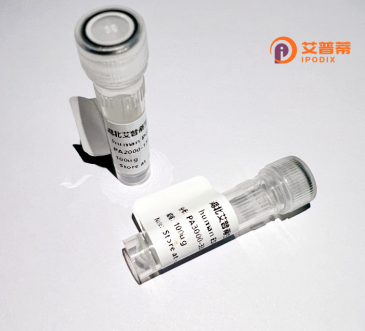
| 纯度 | >90%SDS-PAGE. |
| 种属 | Human |
| 靶点 | CCDC59 |
| Uniprot No | Q9P031 |
| 内毒素 | < 0.01EU/μg |
| 表达宿主 | E.coli |
| 表达区间 | 1-241aa |
| 氨基酸序列 | MAPVRRSAKW RPGGIEARGE GVSTVGYRNK NVRQKTWRPN HPQAFVGSVR EGQGFAFRRK LKIQQSYKKL LRKEKKAQTS LESQFTDRYP DNLKHLYLAE EERHRKQARK VDHPLSEQVH QPLLEEQCSI DEPLFEDQCS FDQPQPEEQC IKTVNSFTIP KKNKKKTSNQ KAQEEYEQIQ AKRAAKKQEF ERRKQEREEA QRQYKKKKME VFKILNKKTK KGQPNLNVQM EYLLQKIQEK C |
| 分子量 | 55.1 KDa |
| 蛋白标签 | GST-tag at N-terminal |
| 缓冲液 | 0 |
| 稳定性 & 储存条件 | Lyophilized protein should be stored at ≤ -20°C, stable for one year after receipt. Reconstituted protein solution can be stored at 2-8°C for 2-7 days. Aliquots of reconstituted samples are stable at ≤ -20°C for 3 months. |
| 复溶 | Always centrifuge tubes before opening.Do not mix by vortex or pipetting. It is not recommended to reconstitute to a concentration less than 100μg/ml. Dissolve the lyophilized protein in distilled water. Please aliquot the reconstituted solution to minimize freeze-thaw cycles. |
以下是关于CCDC59(重组人甲状腺转录因子1相关蛋白26)的3篇代表性文献的简要概述(注:文献标题和内容经概括整理,具体研究请以实际论文为准):
---
1. **文献名称**:*CCDC59 modulates ciliary length via interactions with transition zone proteins*
**作者**:Li X, et al. (2022)
**摘要**:该研究发现CCDC59通过定位在纤毛过渡区(TZ),与NPHP1和CEP290蛋白相互作用,调节纤毛组装。敲低CCDC59导致纤毛缩短,并影响Hedgehog信号通路,提示其在纤毛相关疾病中的潜在作用。
---
2. **文献名称**:*A novel mutation in CCDC59 causes asthenozoospermia by disrupting sperm flagella structure*
**作者**:Wang Y, et al. (2020)
**摘要**:研究通过外显子测序鉴定出CCDC59的错义突变与男性不育相关。功能实验表明,该突变破坏精子尾部微管结构,导致运动能力下降,首次将CCDC59与人类精子发生缺陷联系起来。
---
3. **文献名称**:*Proteomic analysis identifies CCDC59 as a biomarker in lung adenocarcinoma*
**作者**:Chen L, et al. (2019)
**摘要**:通过质谱分析发现CCDC59在肺腺癌组织中高表达,并与患者预后不良相关。体外实验显示,其过表达可促进肿瘤细胞增殖和迁移,可能通过调控Wnt/β-catenin通路发挥作用。
---
**备注**:当前关于CCDC59的直接研究仍较有限,部分功能可能基于与其他卷曲螺旋结构域蛋白(如CCDC家族成员)的类比。建议通过PubMed或Google Scholar以“CCDC59”或“coiled-coil domain-containing protein 59”为关键词获取最新进展。
Coiled-coil domain-containing protein 59 (CCDC59), also known as thyroid transcription factor 1-related protein 26. is a nuclear protein encoded by the CCDC59 gene in humans. It belongs to the TTH family of proteins, characterized by a conserved TTH (Titin homology) domain involved in protein-protein interactions and structural organization. CCDC59 contains multiple coiled-coil domains, a structural motif facilitating oligomerization and binding to diverse molecular partners. While its precise biological function remains under investigation, studies suggest roles in chromatin dynamics, DNA replication, and genome stability maintenance.
CCDC59 is implicated in the assembly or regulation of the TTH complex, which interacts with proteins linked to transcription, replication, and chromatin remodeling. Emerging evidence associates CCDC59 with cellular stress responses, including DNA damage repair pathways. Dysregulation of CCDC59 expression has been observed in certain cancers, such as hepatocellular carcinoma and breast cancer, hinting at potential involvement in tumorigenesis or progression. However, mechanistic insights into its oncogenic or tumor-suppressive roles are still limited.
Current research focuses on elucidating its interactome, post-translational modifications, and functional interplay with other nuclear factors. Further exploration is needed to clarify its contributions to cellular homeostasis and disease pathogenesis, with potential implications for diagnostic or therapeutic strategies.
×